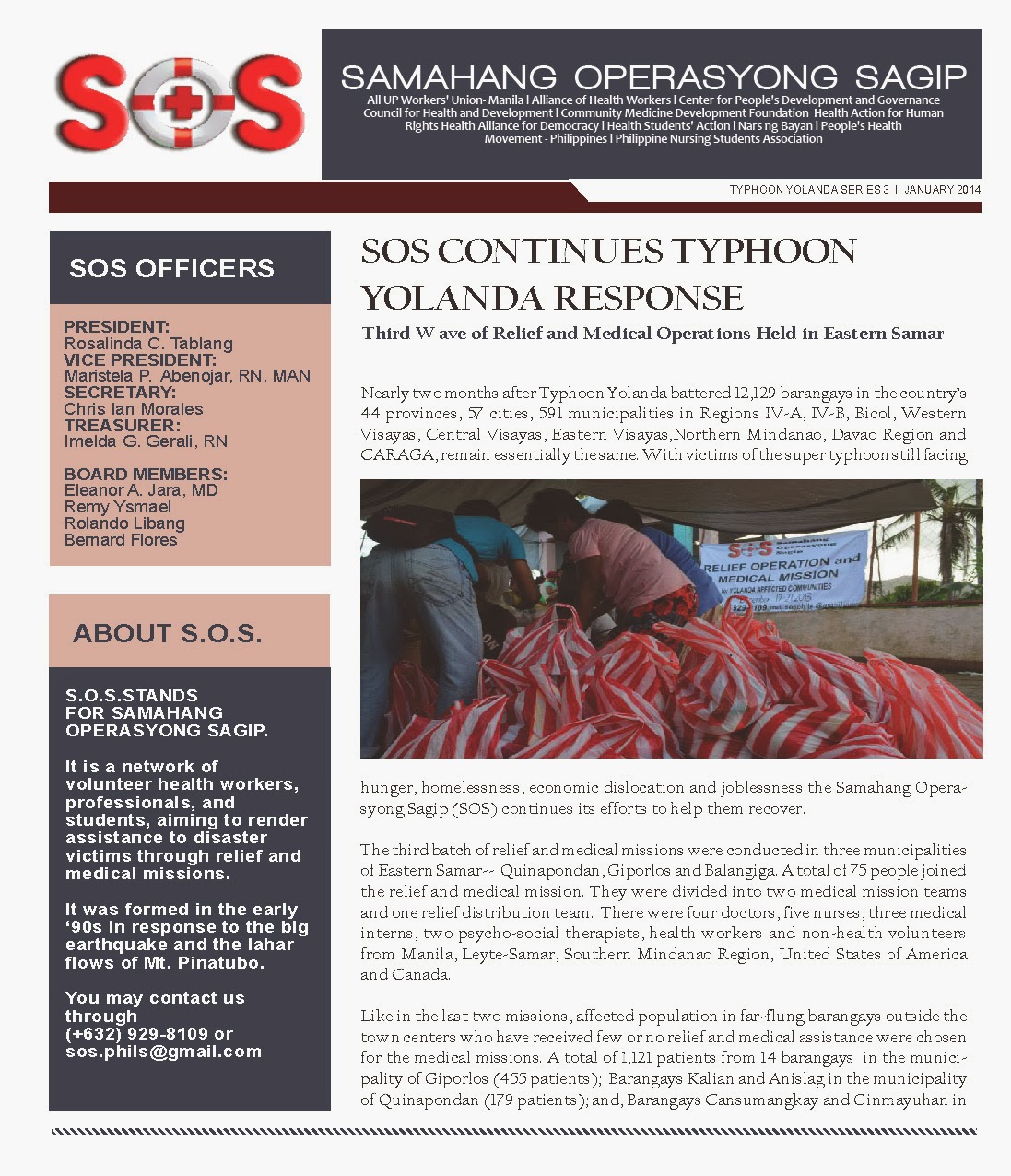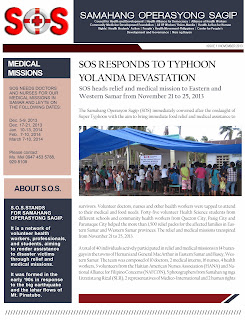You may read the SOS Newsletter Issue 3 here or
or download it here
Nearly two months after Typhoon Yolanda battered 12,129
barangays in the country’s 44 provinces, 57 cities, 591 municipalities in
Regions IV-A, IV-B, Bicol, Western Visayas, Central Visayas, Eastern
Visayas,Northern Mindanao, Davao Region and CARAGA, remain essentially the
same. With victims of the super typhoon still facing Nearly two months after
Typhoon Yolanda battered 12,129 barangays in the country’s 44 provinces, 57
cities, 591 municipalities in Regions IV-A, IV-B, Bicol, Western Visayas,
Central Visayas, Eastern Visayas,Northern Mindanao, Davao Region and CARAGA,
remain essentially the same. With victims of the super typhoon still facing
hunger, homelessness, economic dislocation and joblessness the Samahang
Operasyong Sagip (SOS) continues its efforts to help them recover.
The third batch of relief and medical missions were
conducted in three municipalities of Eastern Samar-- Quinapondan, Giporlos and
Balangiga. A total of 75 people joined the relief and medical mission. They
were divided into two medical mission teams and one relief distribution team.
There were four doctors, five nurses, three medical interns, two psycho-social
therapists, health workers and non-health volunteers from Manila, Leyte-Samar,
Southern Mindanao Region, United States of America and Canada.
Like in the last two missions, affected population in
far-flung barangays outside the town centers who have received few or no relief
and medical assistance were chosen for the medical missions. A total of 1,121
patients from 14 barangays in the municipality of Giporlos (455 patients);
Barangays Kalian and Anislag in the municipality of Quinapondan (179 patients);
and, Barangays Cansumangkay and Ginmayuhan in the municipality of Balangiga
were served. The most common medical cases included upper respiratory tract
infections, acute gastro-enteritis and hypertension, tension headache among
adults; and fever, diarrhea, cough and colds among children. These ailments
were also observed in the first and second waves of SOS medical missions in Eastern,
Western Samar and Leyte provinces.
Twelve psycho-social therapy sessions among children and
mothers in the selected barangays of Quinapondan, Giporlos and Balangiga were
conducted by the mission team. There were nine therapy sessions for children
and 3 therapy batches for mothers, benefitting a total of 550 children and 150
mothers. The psycho-social team effectively made use of play therapy (for
children and adults), experience sharing and exercise methods (for adults) to
help them process what they have gone through with Typhoon Yolanda. Eleven
individuals were provided psycho-social counseling. The relief drive operations
on the
other hand, benefitted 2,376 families from 13 selected
barangays in the towns of Quinapondan, Giporlos, and Balangiga. They were able
to receive relief packs, clothes, plastic sheets, building materials like
nails, saw, and hammers. The mission team also gave hundreds of Christmas
Goodies Packs for children. Six water filtration pails were given to
representatives of the barangays in the towns of Giporlos and Balangiga.
As in the previous relief and medical missions, health risks
such as the lack of potable water supply, lack of electricity, nails and
pointed objects in debris that could lead to disease outbreaks and accidents
were noted. The number of diagnosed diarrhea cases among children and cases of
acute gastroenteritis among adults proved the risk of a possible disease
outbreak. Most people in affected barangays are trying to rebuild their homes
and lives. Yet many barangays especially those far from town centers are still
in need of assistance, food, supplies, and construction materials. The affected
families shared their hopes that they may be assisted in
repairing/reconstructing their homes and in regaining their lost livelihood
especially in starting up food production and their fishing activity.
People’s participation in planning and actual implementation in relief and
rehabilitation efforts is important to ensure relevance of relief efforts and
medical services. SOS thus maintains and reiterates the following
recommendations:
1. Government’s relief and medical assistance should include
far-flung barangays. Many communities especially those located in the upland
received very little assistance while many shared that they have not received
any assistance at all.
2. There is a great need to provide assistance for people to
rebuild theirhomes and communities, through provision of construction materials
including GI sheets, nails, hammer, saw, etc. The government should reconsider
the Department of Trade and Industry (DTI) program of selling GI sheets that is
beyond the capacity of the affected population.
3. Immediate and comprehensive health interventions to
address potential sources of outbreaks and epidemics. These include immediate
clearing of debris, provision of safe/potable water source, construction of
shelter, provision/ assistance in food production and livelihood.
4. Assistance for livelihood and rehabilitation- livelihood,
food production and economic activities. ##
------------------------------------------------------------------------------------------------
------------------------------------------------------------------------------------------------
You may read the SOS Newsletter Issue 2 here or
or download it here
One month after Typhoon Yolanda’s onslaught, the fate of millions is still in limbo. With victims of the super typhoon facing homelessness, joblessness and hunger, the Samahang Operasyong Sagip (SOS) continues its efforts in helping them get back on their feet once more.
The second series of medical missions and relief drive operations were conducted in 9 barangays in the 3 municipalities of Leyte- Albuera, Ormoc and Kananga. A total of 41 individuals, 5 of which were doctors, 11 nurses, 3 medical interns, and health workers and volunteers from Leyte-Samar, Manila, Surigao del Sur, Cebu, and United States of America comprised the medical and relief mission team. They were divided into 2 medical mission teams and 1 relief distribution team.
Families from far-flung areas outside the town centers ,who have received few or no relief assistance and medical mission since the typhoon, were chosen for the medical missions and relief drive operations.
A total of 1,942 patients from Barangays Tinag-an, Antipolo and Mahayag in the Municipality of Albuera; Barangays Lunoy, Sto. Domingo and Natubgan in the Municipality of Kananga; and Barangay Ipil in Ormoc were served. Meanwhile, the relief drive operations benefitted 1,436 families from selected barangays in the towns of Albuera, Ormoc, and Kananga. They were able to receive relief packs, plastic sheets, building materials like nails, saw, hammers, cooking pots, and used clothes. Three water filtration pails were given to representatives of the three towns for use of the communities.
The most common medical cases included upper respiratory tract infections, hypertension, wounds or injuries, skin infections, acute gastro enteritis, diarrheal diseases, tension headache and insomnia. These ailments were also observed in the first wave of SOS medical missions in Eastern and Western Samar. The people in Tinag-an, Albuera requested for psychosocial assistance and tetanus toxoid for wounds sustained during the repairing and rebuilding of their homes.
Major health risks which could lead to serious disease outbreaks were noted. These include the lack of potable water supply, as observed in Barangay Ipil, Ormoc; Lack of adequate and safe shelter and housing; Lack of electricity make night time pitch black and movement in the areas difficult and dangerous; Undernourished children, and; Presence of stagnant water and debris, which are breeding grounds for mosquitoes and other carriers of diseases.
Most people in affected barangays have been trying to rebuild their homes and lives, yet many, especially those far from town centers, are still in dire need of assistance such as food, supplies and construction materials. It is pertinent that they be part of the planning and actual implementation in the relief and rehabilitation efforts so as to ensure relevance of relief efforts and medical services.
We thus recommend the following:
1. Government’s relief and medical assistance should include far-flung barangays.
2. Assistance for people to rebuild their homes and communities, through provision of construction materials including GI sheets, nails, hammer, saw, etc. For sale construction materials promoted by DTI could not be afforded by many especially those whose livelihood was affected.
3. Immediate and comprehensive health interventions to address potential sources of outbreaks and epidemics. These include immediate clearing of debris, provision of a safe water source, construction of shelter, assistance in food production and livelihood.
4. Assistance for livelihood and rehabilitation- provision of construction materials, livelihood, food production, and economic activities. ##
----------------------------------------------------------------------------------------------------
You may read the SOS Newsletter Issue 1 here or
or download it here
The Samahang Operasyon Sagip (SOS) immediately convened after the onslaught of Super Typhoon with the aim to bring immediate food relief and medical assistance to survivors. Volunteer doctors, nurses and other health workers were tapped to attend to their medical and food needs. Forty-five volunteer Health Science students from different schools and community health workers from Quezon City, Pasig City and Paranaque City helped the more than 1,500 relief packs for the affected families in Eastern Samar and Western Samar provinces. The relief and medical missions transpired from November 21 to 25, 2013.
A total of 40 individuals actively participated in the relief and medical missions in 14 barangays in the towns of Hernani and General MacArthur in Eastern Samar and Basey, Western Samar. The team was composed of 10 doctors, 2 medical interns, 16 nurses, 4 health workers, 3 volunteers from the Haitian American Nurses Association (HANA) and National Alliance for Filipino Concerns (NAFCON), five photographers from the Samahan ng mga Litratista ng Rizal (SLR), 2 representatives of Medico-International and 2 human rights workers. A total of 1,088 patients were served while 1,664 families were given relief packages. Table 1 in page 2 shows a detailed account of survivors reached by the missions.
The medical mission team found the affected community members to be suffering from colds and cough, upper respiratory tract infections, hypertension, arthritis, error of refraction, diarrhea, lower and muculo back pain, skin diseases and injuries. There were also a number of obstetrics cases and pulmonary tuberculosis suspects.
The present situation in the visited areas of Eastern and Western Samar is disturbing. In Hernani town, almost 80 percent of houses were damaged, with more than 200 families in Barangay Batang living in make-shift tents. Typhoon Yolanda inflicted serious economic dislocation to the affected families. Fishing, which is the main source of livelihood were crippled as Typhoon Yolanda either destroyed or swept away fishing boats. Coconut trees were uprooted or snapped; hectares upon hectares of rice and root crops were destroyed.
The devastation caused by Typhoon Yolanda once again showed the vulnerability of the people, especially the poor segment of the country’s population to disasters. Amidst the suffering of millions of people who lost their homes, their loved ones and their livelihood, the Samahang Operasyong Sagip (SOS) calls on the people to contribute their resources to the victims of Typhoon Yolanda. SOS also calls on doctors, nurses and health professionals to lend their talent, time and resources to help alleviate the suffering of our fellow countrymen.
SOS scored the government for its inefficiency and inept leadership in responding to the recent emergency. It called on the government to:
1. Lift the December deadline set by the Department of Social Work and Development for food relief assistance. Ensure swift and far-reaching food and non-food relief provision to all Yolanda-affected population.
2. Act on rebuilding the lives and livelihood of the affected population by providing:
• house repair/reconstruction assistance program to families whose houses were destroyed;
• livelihood/economic assistance program which includes provision of fishing boats and important fishing paraphernalia such as fishing nets and cooling boxes;
• agricultural assistance package which includes provision of rice and vegetable seeds, coconut seedlings and important farm implements to resume agricultural activities; livestock dispersal
3. Address the immediate health problems and concerns of the affected population. Concretely, act on:
• malnutrition problem especially among children which will be further worsen by Typhoon Yolanda.
• prevention of epidemic which includes vaccination against cholera, safe and potable water system installation, health and sanitation campaign infrastructure (health education and building of latrines)
• attend to the mental health and wellness of the community.
4. Institute and implement a comprehensive disaster risk reduction program geared at building the capacities of communities in preparing and responding to disasters must be instituted and implemented. Correspondingly, there must be an increase in the budget for Disaster Risk Reduction. ##

.JPG)






No comments:
Post a Comment